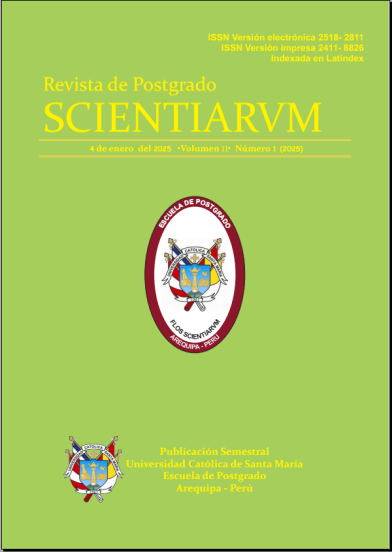EFECTO DEL HIPOCLORITO DE SODIO AL 0.5% Y GLUCONATO DE CLORHESIDINA 0.12% EN EL CRECIMIENTO DE Candida albicans EN DISCOS DE RESINA ACRÍLICA TERMOPOLIMERIZABLE
EFFECT OF SODIUM HYPOCHLORITE TO 0.5% AND GLUCONATE OF CLORHEXIDINA 0.12% IN THE GROWTH OF Candida albicans IN TERMOPOLIMERIZABLE ACRYLIC RESIN DISCS
Elizabeth Mariela Perea Corimaya1, Eliana Aída Guillén Fernández1, Roberto Carlos Tejada Chávez1
- Universidad Católica de Santa María, Arequipa - Perú
RESUMEN: Introducción: La prótesis total en la cavidad bucal es confeccionada con resina acrílica termopolimerizable cuya parte interna está en contacto con el paladar y mucosa, zona donde el hongo (Cándida albicans) puede proliferar rápidamente causando mala adaptación, falta de higiene, lesiones en el paladar del paciente. Objetivo: Comparar la eficacia in vitro del Hipoclorito de Sodio (0.5%) vs Gluconato de Clorhexidina (0.12%) en el crecimiento de (C. albicans) en discos de resina acríllica termopolimerizable. Materiales y métodos: En el estudio experimental de corte longitudinal, se incluyeron 30 discos de resina acrílica termopolimerizable distribuidas en dos grupos experimentales, teniendo como criterio de Inclusión ser discos de acrílico de termocurado sembradas con (C.albicans) Se realizó un examen mcrobiológico tomando tres muestras a los 15, 30 y 60 minutos. Se utilizaron las pruebas T-Student para comparación de medias intragrupos y una prueba ANOVA para comparaciones múltiples. Resultados: Tanto el Hipoclorito de Sodio (0.5%) como el Gluconato de Clorhexidina (0.12%) han demostrado ser eficaces en disminuir el crecimiento de cándida albicans en discos de resina acrílica termopolimerizable, así lo demostró la diferencia de las medias de turbidez entre los 15, 30 y 60 minutos. Conclusiones: Los resultados de la prueba T de Student demuestran que no existe diferencia estadísticamente significativa en el efecto de ambos productos sobre el crecimiento de (C. albicans) en discos de resina acrílica termopolimerizable.
Palabras claves: C. albicans, Hipoclorito de Sodio, Gluconato de Clorhexidina
ABSTRACT: The total prosthesis in the oral cavity is made with thermopolymerizable acrylic resin whose internal part is in contact with the palate and mucosa, an area where the fungus (Candida albicans) can proliferate rapidly causing poor adaptation, lack of hygiene, lesions on the patient's palate . Objective: To compare the in vitro efficacy of Sodium Hypochlorite (0.5%) vs Chlorhexidine Gluconate (0.12%) in the growth of (C. albicans) in thermopolymerizable acrylic resin discs. Materials and methods: In the experimental study of longitudinal section, 30 thermopolymerizable acrylic resin disks were included distributed in two experimental groups, having as Inclusion criteria being thermo-curing acrylic disks seeded with (C. albicans) A microbiological examination was carried out taking three samples at 15, 30 and 60 minutes. T-Student tests were used for comparison of intragroup means and an ANOVA test for multiple comparisons. Results: Both Sodium Hypochlorite (0.5%) and Chlorhexidine Gluconate (0.12%) have been shown to be effective in reducing the growth of candida albicans in thermopolymerizable acrylic resin discs, as demonstrated by the difference in the turbidity means between the 15, 30 and 60 minutes. Conclusions: The results of the Student's t test show that there is no statistically significant difference in the effect of both products on the growth of (C. albicans) in thermopolymerizable acrylic resin discs.
Words Key: C. albicans, Sodium Hipoclorite, Gluconate of Clorhexidina
Revista Seleccionada
Enero 2020 Volumen 6 - Número 1 P 23-26
DOI: 10.26696/sci.epg.0109
Enlaces
EDITORIAL
CIENCIAS SOCIALES Y HUMANIDADES
PROTECCION DEL MEDIO AMBIENTE EN LAS COMUNIDADES CAMPESINAS, SEGUN TRIBUNAL CONSTITUCIONAL
SATISFACCION DEL ESTUDIANTE RESPECTO A LA EDUCACION VIRTUAL EN TIEMPOS DE COVID-19
CIENCIAS BIOLÓGICAS Y DE SALUD


